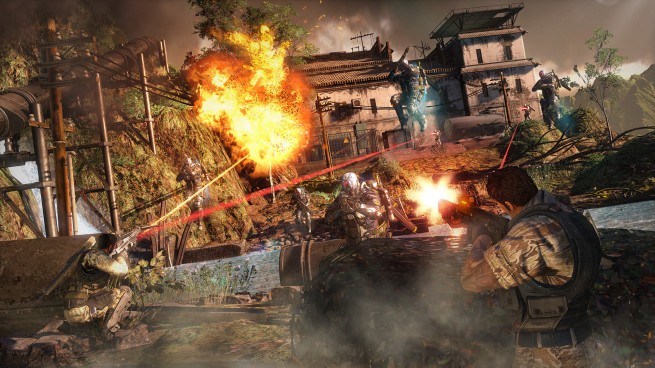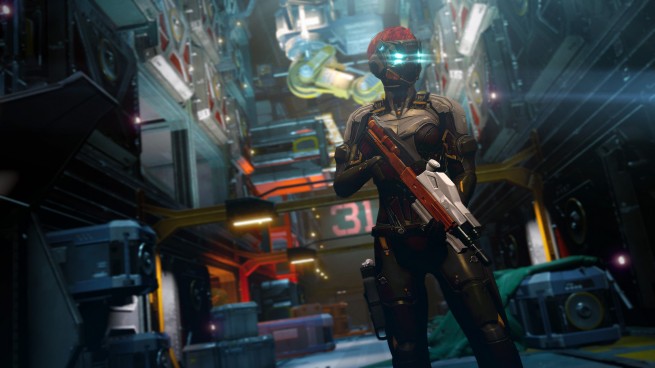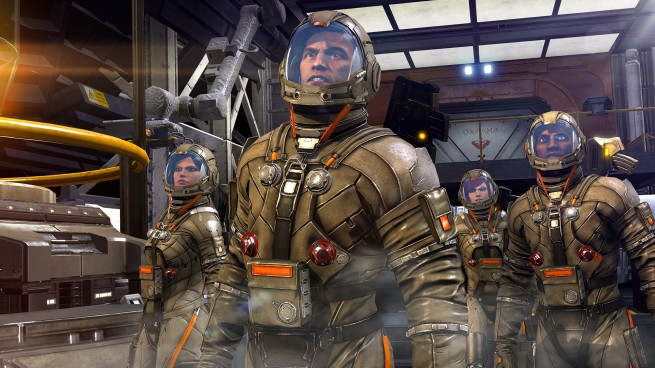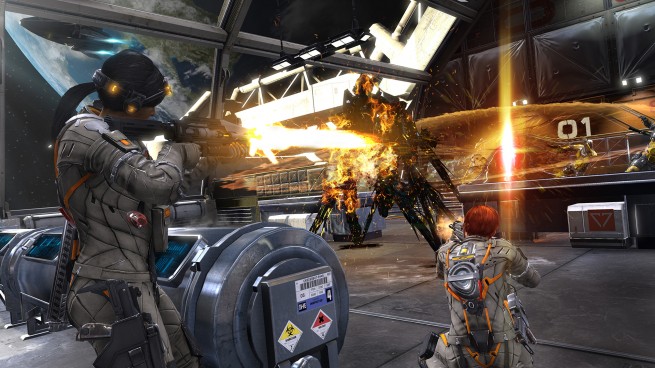When Fuse works, it’s a blast. The combat explodes into clouds of fun as you destroy and enjoy with your straight-out-of-science-fiction instruments of virtual death. The co-op third-person shooter’s skirmishes have a seductive cadence that keeps you close to your controller. Each trigger squeeze can elicit a squeal of joy from your inner 13-year-old. Fuse has that power, and that’s an impressive weapon in its own right.
Electronic Arts’ multiplatform, multiplayer action offering, releasing today, does the most important thing right. And when you’re able to assemble your own A-team of friends-list recruited mercs, Fuse can deliver borderline-special moments.
But what happens between the reloads? That’s where it gets complicated.
What you’ll like
Crazy, combo-heavy combat
Fuse’s combat feels tight and well balanced. After all, the shooter-crazed minds at Insomniac Games developed the title, and the studio’s vast experience is evident in every bullet-pocked design decision.
This thinking led to Fuse’s inventive arsenal, which includes a soldier-incinerating Magshield, singularity-inducing Warp Rifle, crystal-forming Shattergun, and fire-chaining Arcshot. Combined with standard-issue weapons like assault rifles, shotguns, sniper rifles, and pistols, your munitions leave you with plenty of options. Firearms can work together just like the combatants themselves, allowing you to kill with cleverness. So if your friend encapsulates a bad guy in black melanite with her Shattergun, you can splinter the macabre chrysalis with your Daybreaker semi-automatic.
Building on this point, Fuse features a slick combo system that nets you level-boosting experience points for your squad members. Expertly executed shots, selfless acts of healing, and other team-centric actions result in valuable XP that you can spend on character upgrades.
The mechanic reminds me of other shoot-happy releases like Bulletstorm that reward creative aggression. And these point bonuses add an intriguing layer to the gunplay, encouraging you to throw a little swagger into your strategy.
Fragging with friends
Being a co-op shooter, you’ll get the most out of Fuse with a group of your most trusted digital veterans. Its A.I., while serviceable, tends to have trouble with advanced flanking techniques, and it can also take a while to revive you if you’re dying.
Playing with a friend or two (or three) will help you survive the campaign’s final missions. And human partners are an absolute requirement for the Echelon mode that sends wave after wave of increasingly difficult enemy swarms at your crew. Plus, the aforementioned weapon combinations really stand out when fighting alongside flesh-and-blood compatriots.
Switch things up in the middle of a firefight
Your team comprises of four different personalities, including the burly Dalton, stealthy Naya, practical Izzy, and dependable Jacob. Each character gets a special weapon (Magshield, Warp Rifle, Shattergun, and Arcshot, respectively). You may switch characters on the fly through the game’s Leap functionality. With a quick button press, you can jump from one team member to another, gaining new abilities in the process.
Leap let me instantly adjust my tactics during hostile encounters, and it also helped me understand the strengths and weaknesses of my unit in a fresh and unexpected manner.
What you won’t like
You barely know your enemies, your allies, and your mission
Fuse throws you right into its fighting, but it does so without giving you much of a setup. The narrative has a need-to-know-basis kind of edge to it that left me wondering about whom I was fighting and why. You don’t even know much about your own group and your mysterious handler named Oculus. All you do know is that you’re playing as mercenaries that are fighting other mercenaries — all because of a mysterious energy source known as Fuse.
Unfortunately, I received very few answers to my lingering questions as I traveled the world and outer space. Fuse gives you some morsels here and there — just enough to explain why you’re going underwater to a hidden base or ambushing a sprawling Indian palace. But the storyline ultimately falls flat — even with the attempted gotcha moments.
Twists don’t really work when you have very little to twist.
Understated Overstrike
When Fuse first started out as Overstrike, the game debuted with a trailer chock full of snark and sass. The final product, however, is a significant departure from that vibrant proof of concept. Sure, the characters are still there, sort of. Your group is still called Overstrike 9. And its signature weapons retain similar wacky properties.
But everything else suffers from that glossy, over-scrutinized patina that only comes from relentless corporate escalation and focus-group testing. The artwork lost its cartoony flair. The character design feels safer. The result is more crowd-pleasing than genre-redefining.
Albeit for some random one-liners that you hear during the campaign (for some reason Dalton hates cats), the sass is pretty much gone. For a title that plays so stylishly, its presentation deserves an equal amount of sizzle.
BWOMP … am I supposed to hear music over this … BWOMP
Do you enjoy foghorns? I’m talking about speaker-rattling, Leonardo DiCaprio-approved foghorns. The type straight out of big-budget Hollywood mind-bending thrillers. You like those? Then you’ll love Fuse’s soundtrack. It mainly consists of lethargic brown notes coupled with frantic tribal drums. The title screen immediately bombards you with the sound. While you’d initially think that the drone is an ominous bit of foreshadowing, it never really goes away. And it eventually loses its impact as it slowly helps you lose your sanity.
Yeah, you’ll occasionally hear other orchestral pieces, but you’ll just … BWOMP … forget about them.
Get ready to explore lots and lots of labs
You’ll journey through multiple environments while playing Fuse such as deep-ocean labs, labs in the middle of a jungle, mountaintop labs, labs orbiting our planet, and so forth. Yep, loads of labs. And you’ll also see tons of industrial spaces with metallic crates of all shapes. These areas look like big … labs.
Fuse has some interesting backdrops. Yet most of the time, you’ll fight in the same environments, except for an updated view out the window. Some of the missions have multiple outdoor sections, forcing you to brave the elements. These sequences help add variety, but they’re short and superficial. Barring a couple of significant moments, the vast majority of your playtime will take place inside monotonous metal walls.
Collectibles get in the way of your objectives
As you play through the campaign, you can look for different collectibles spread throughout each location you visit. These pickups consist of XP boosters, Fuse credits that you can use to unlock team-based perks, and pieces of intel that touch on story points.
When I played alone, I took my time to comb each room in search of these hidden treasures. When I played with friends, however, I stopped looking. Fuse puts pressure on you to regroup at specific rally points, and this artificial urgency intensified when I knew actual people were waiting for me. I decided that it wasn’t worth the potential hassle to make my comrades hold while I hunted for these things.
Conclusion
Like I said, Fuse is fun. I’ll even say it’s really fun. Today’s big-budget-shooter culture tends to suppress uniqueness in favor of it’s-what-the-people-want convention. And in this maelstrom, many publishers have forgotten that we all play video games to have a good time. Even though nefarious forces have noticeably tainted other parts of the title, Fuse’s spirit shines through its unabashedly likable gameplay.
Making a group of enemies disappear in a chain of miniature black holes with your Warp Rifle is ridiculous. More important, it’s ridiculously entertaining.
score: 78/100
Fuse released on May 28, 2013 for the PlayStation 3 and Xbox 360. The publisher provided GamesBeat with a PS3 copy of the game for the purpose of this review.
VentureBeat's mission is to be a digital town square for technical decision-makers to gain knowledge about transformative enterprise technology and transact. Learn More





